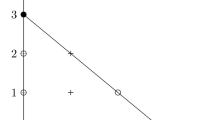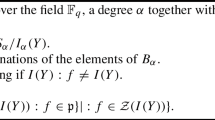Abstract
The aim of this work is to give degree formulas for the generalized Hamming weights of evaluation codes and to show lower bounds for these weights. In particular, we give degree formulas for the generalized Hamming weights of Reed–Muller-type codes, and we determine the minimum distance of toric codes over hypersimplices, and the 1st and 2nd generalized Hamming weights of squarefree evaluation codes.

Similar content being viewed by others
References
Aigner M.: Combinatorial Theory. Springer, Berlin (1997).
Atiyah M.F., Macdonald I.G.: Introduction to Commutative Algebra. Addison-Wesley, Reading, MA (1969).
Ballico E., Elia M., Sala M.: On the evaluation of multivariate polynomials over finite fields. J. Symb. Comput. 50, 255–262 (2013).
Becker T., Weispfenning V.: Gröbner Bases A Computational Approach to Commutative Algebra, in Cooperation with Heinz Kredel. Graduate Texts in Mathematics, vol. 141. Springer, New York (1993).
Beelen P.: A note on the generalized Hamming weights of Reed–Muller codes. Appl. Algebra Eng. Commun. Comput. 30(3), 233–242 (2019).
Beelen P., Datta M.: Generalized Hamming weights of affine Cartesian codes. Finite Fields Appl. 51, 130–145 (2018).
Bosma W., Cannon J., Playoust C.: The Magma algebra system. I. The user language. J. Symb. Comput. 24, 235–265 (1997).
Carvalho C.: On the second Hamming weight of some Reed–Muller type codes. Finite Fields Appl. 24, 88–94 (2013).
Carvalho C., Lopez Neumann V.G., López H.H.: Projective nested cartesian codes. Bull. Braz. Math. Soc. 48(2), 283–302 (2017).
Cooper S.M., Seceleanu A., Tohǎneanu S.O., Vaz Pinto M., Villarreal R.H.: Generalized minimum distance functions and algebraic invariants of Geramita ideals. Adv. Appl. Math. 112, 101940 (2020).
Cox D., Little J., O’Shea D.: Ideals, Varieties, and Algorithms. Springer, Berlin (1992).
Duursma I.M., Rentería C., Tapia-Recillas H.: Reed–Muller codes on complete intersections. Appl. Algebra Eng. Commun. Comput. 11(6), 455–462 (2001).
Geil O.: Evaluation codes from an affine variety code perspective. In: Advances in Algebraic Geometry Codes. Series on Coding Theory and Cryptology, vol. 5, pp. 153–180. World Scientific Publishing, Hackensack, NJ (2008).
Geil O., Høholdt T.: Footprints or generalized Bezout’s theorem. IEEE Trans. Inf. Theory 46(2), 635–641 (2000).
Geil O., Pellikaan R.: On the structure of order domains. Finite Fields Appl. 8(3), 369–396 (2002).
Geramita A.V., Kreuzer M., Robbiano L.: Cayley–Bacharach schemes and their canonical modules. Trans. Am. Math. Soc. 339(1), 163–189 (1993).
Ghorpade S.: A note on Nullstellensatz over finite fields. In: Contributions in Algebra and Algebraic Geometry. Contemporary Mathematics, vol. 738, pp. 23–32. American Mathematical Society, Providence, RI (2019).
González-Sarabia M., Camps E., Sarmiento E., Villarreal R.H.: The second generalized Hamming weight of some evaluation codes arising from a projective torus. Finite Fields Appl. 52, 370–394 (2018).
González-Sarabia M., Martínez-Bernal J., Villarreal R.H., Vivares C.E.: Generalized minimum distance functions. J. Algebr. Comb. 50(3), 317–346 (2019).
González-Sarabia M., Rentería C., Hernández de la Torre M.: Minimum distance and second generalized Hamming weight of two particular linear codes. Congr. Numer. 161, 105–116 (2003).
González-Sarabia M., Rentería C., Tapia-Recillas H.: Reed–Muller-type codes over the Segre variety. Finite Fields Appl. 8(4), 511–518 (2002).
Grayson D., Stillman M.: Macaulay\(2\). Available at http://www.math.uiuc.edu/Macaulay2/ (1996).
Greuel G.M., Pfister G.: A Singular Introduction to Commutative Algebra, 2nd extended edn. Springer, Berlin (2008).
Hansen J.: Toric surfaces and error-correcting codes. In: Coding Theory, Cryptography, and Related Areas, pp. 132–142. Springer, Berlin (2000).
Heijnen P., Pellikaan R.: Generalized Hamming weights of \(q\)-ary Reed–Muller codes. IEEE Trans. Inf. Theory 44(1), 181–196 (1998).
Helleseth T., Kløve T., Mykkelveit J.: The weight distribution of irreducible cyclic codes with block lengths \(n_1((q^l-1)/N)\). Discret. Math. 18, 179–211 (1977).
Huffman W.C., Pless V.: Fundamentals of Error-Correcting Codes. Cambridge University Press, Cambridge (2003).
Jacobson N.: Basic Algebra I, 2nd edn. W. H. Freeman and Company, New York (1996).
Johnsen T., Verdure H.: Generalized Hamming weights for almost affine codes. IEEE Trans. Inf. Theory 63(4), 1941–1953 (2017).
Joyner D.: Toric codes over finite fields. Appl. Algebra Eng. Commun. Comput. 15(1), 63–79 (2004).
Koblitz N.: A Course in Number Theory and Cryptography, 2nd edn. Graduate Texts in Mathematics, vol. 114. Springer, New York (1994).
Kreuzer M., Robbiano L.: Computational Commutative Algebra 2. Springer, Berlin (2005).
Kreuzer M., Robbiano L.: Computational Linear and Commutative Algebra. Springer, Cham (2016).
Lachaud G.: The parameters of projective Reed–Muller codes. Discret. Math. 81(2), 217–221 (1990).
Little J.: Remarks on generalized toric codes. Finite Fields Appl. 24, 1–14 (2013).
López H.H., Matthews G., Soprunov I.: Monomial-Cartesian codes and their duals, with applications to LCD codes, quantum codes, and locally recoverable codes. Des. Codes Cryptogr. 88(8), 1673–1685 (2020).
López H.H., Rentería C., Villarreal R.H.: Affine cartesian codes. Des. Codes Cryptogr. 71(1), 5–19 (2014).
López H.H., Sarmiento E., Vaz Pinto M., Villarreal R.H.: Parameterized affine codes. Stud. Sci. Math. Hung. 49(3), 406–418 (2012).
MacWilliams F.J., Sloane N.J.A.: The Theory of Error-Correcting Codes. North-Holland, Amsterdam (1977).
Martínez-Bernal J., Pitones Y., Villarreal R.H.: Minimum distance functions of graded ideals and Reed–Muller-type codes. J. Pure Appl. Algebra 221, 251–275 (2017).
Martínez-Bernal J., Pitones Y., Villarreal R.H.: Minimum distance functions of complete intersections. J. Algebra Appl. 17(11), 1850204 (2018).
Martínez-Bernal J., Valencia-Bucio M.A., Villarreal R.H.: Linear codes over signed graphs. Des. Codes Cryptogr. 88(2), 273–296 (2020).
Mercier D.J., Rolland R.: Polynômes homogènes qui s’annulent sur l’espace projectif \({\rm P}^m({ F}_q)\). J. Pure Appl. Algebra 124(1–3), 227–240 (1998).
O’Carroll L., Planas-Vilanova F., Villarreal R.H.: Degree and algebraic properties of lattice and matrix ideals. SIAM J. Discret. Math. 28(1), 394–427 (2014).
Patanker N., Singh S.K.: Generalized Hamming weights of toric codes over hypersimplices and square-free affine evaluation codes. Preprint (2020). arXiv:2002.10920 [math.AC].
Ruano D.: On the structure of generalized toric codes. J. Symb. Comput. 44(5), 499–506 (2009).
Sarmiento E., Vaz Pinto M., Villarreal R.H.: The minimum distance of parameterized codes on projective tori. Appl. Algebra Eng. Commun. Comput. 22(4), 249–264 (2011).
Seidenberg A.: Constructions in algebra. Trans. Am. Math. Soc. 197, 273–313 (1974).
Soprunov I.: Lattice polytopes in coding theory. J. Algebra Comb. Discret. Struct. Appl. 2(2), 85–94 (2015).
Sørensen A.: Projective Reed–Muller codes. IEEE Trans. Inf. Theory 37(6), 1567–1576 (1991).
Stanley R.: Hilbert functions of graded algebras. Adv. Math. 28, 57–83 (1978).
Stanley R.: Enumerative Combinatorics, vol. 1, 2nd edn. Cambridge Studies in Advanced Mathematics, vol. 49. Cambridge University Press, Cambridge (2012).
Stichtenoth H.: Algebraic Function Fields and Codes, 2nd edn. Graduate Texts in Mathematics, vol. 254. Springer, Berlin (2009).
Sturmfels B.: Gröbner Bases and Convex Polytopes, University Lecture Series, vol. 8. American Mathematical Society, Rhode Island (1996).
Tsfasman M., Vladut S., Nogin D.: Algebraic Geometric Codes: Basic Notions. Mathematical Surveys and Monographs, vol. 139. American Mathematical Society, Providence, RI (2007).
Villarreal R.H.: Monomial Algebras, 2nd edn. Monographs and Research Notes in Mathematics. Chapman and Hall/CRC, Boca Raton, FL (2015).
Wei V.K.: Generalized Hamming weights for linear codes. IEEE Trans. Inf. Theory 37(5), 1412–1418 (1991).
Acknowledgements
The authors thank Nupur Patanker for pointing out an error in the previous statements of Corollary 4.6 and Proposition 5.1. We thank the referees for a careful reading of the paper and for the improvements suggested. We also thank Hiram López for helpful comments about the computation of radicals over finite fields. Computations with Magma [7] and Macaulay2 [22] were important to give examples and to have a better understanding of evaluation codes.
Author information
Authors and Affiliations
Corresponding author
Additional information
Communicated by G. Korchmaros.
Publisher's Note
Springer Nature remains neutral with regard to jurisdictional claims in published maps and institutional affiliations.
Delio Jaramillo was supported by a scholarship from CONACYT, Mexico. Maria Vaz Pinto was partially supported by the Center for Mathematical Analysis, Geometry and Dynamical Systems of Instituto Superior Técnico, Universidade de Lisboa. Rafael H. Villarreal was supported by SNI, Mexico.
Appendix A: Procedures for Magma and Macaulay2
Appendix A: Procedures for Magma and Macaulay2
In this section we give procedures, over finite fields, for Magma [7] and Macaulay2 [22] that are used to compute generalized Hamming weights and degree-footprint lower bounds of evaluation codes. In Procedure A.4 we use a pure lexicographical order. In all other procedures we use the graded reverse lexicographical order [56, p. 343], which is the default order.
Procedure A.1
Computing the generalized Hamming weights and footprints of an evaluation code \({\mathcal {L}}_X\) on X using Theorem 3.4, Proposition 3.5 and its constructive proof, and Theorem 3.9. The input for this procedure is a generating set for \({\mathcal {L}}\) and the vanishing ideal I of X. This procedure corresponds to Example 6.1. For the case \({\mathcal {L}}=S_d\), see Procedure A.2 below.

Procedure A.2
Given an evaluation code \({\mathcal {L}}_X\) on X and a monomial order \(\prec \) on S. Using Proposition 3.5 and its constructive proof, this procedure computes a linear subspace \(\widetilde{{\mathcal {L}}}\) of S such that \(\widetilde{{\mathcal {L}}}_X\) is a standard evaluation code on X and \(\widetilde{{\mathcal {L}}}_X={\mathcal {L}}_X\). Then, using Theorem 3.4, it computes the r-generalized Hamming weight of a projective Reed–Muller-type code on X of degree d. This procedure corresponds to Example 6.2. In this procedure \({\mathcal {L}}\) is the linear subspace \(S_d\) of S of homogeneous polynomials of degree d together with the zero vector. To compute \(\delta _r({\mathcal {L}}_X)\) for an evaluation code \({\mathcal {L}}_X\) replace basis(d,S) by the matrix of a K-basis of the linear space \({\mathcal {L}}\) (see Procedure A.1).

Procedure A.3
Computing the generalized Hamming weights of a Reed–Muller-type code \(C_X(d)\) using Corollary 3.6. This procedure corresponds to Example 6.3. Other examples can be computed changing the finite field and the set of points of X.

Procedure A.4
Computing the quotient and the remainder in the multivariate division algorithm [11, Theorem 3, p. 63]. This procedure corresponds to Example 6.4.

Procedure A.5
Computing the minimum distance of a Reed–Muller-type code \(C_X(d)\) of degree d using Corollary 3.7. This procedure corresponds to Example 6.5.

Procedure A.6
Computing the footprint of a Reed–Muller-type code \(C_X(d)\). This procedure corresponds to Example 6.6. To compute other examples just change the finite field and the vanishing ideal I of X.

Procedure A.7
Computing the length, dimension, and minimum distance of a Reed–Muller-type code \(C_X(d)\) over an affine variety \(X=V_{{\mathbb {A}}^s}(G)\) defined by a given set of multivariate polynomials G. This procedure uses Lemma 2.5, Corollary 3.7, and Hilbert’s Nullstellensatz of Theorem 3.12. As an illustration we use the Hermitian curve g of Example A.7.

Procedure A.8
Computing the number of points of an affine variety over a finite field using Lemma 2.8. This procedure corresponds to the elliptic curve of Example 6.8. To compute other examples just change the finite field and the set of polynomials F that define the affine variety.

Procedure A.9
Computing the radical of an ideal over a finite field using Magma [7]. This procedure corresponds to Example 6.9.

Rights and permissions
About this article
Cite this article
Jaramillo, D., Vaz Pinto, M. & Villarreal, R.H. Evaluation codes and their basic parameters. Des. Codes Cryptogr. 89, 269–300 (2021). https://doi.org/10.1007/s10623-020-00818-8
Received:
Revised:
Accepted:
Published:
Issue Date:
DOI: https://doi.org/10.1007/s10623-020-00818-8
Keywords
- Evaluation codes
- Toric codes
- Minimum distance
- Affine torus
- Footprint
- Degree
- Reed–Muller codes
- Generalized Hamming weights
- Affine variety
- Finite field
- Gröbner bases




